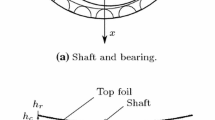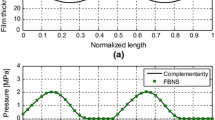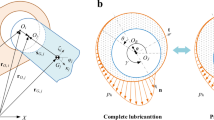Abstract
Interference fits are widely used for connecting impeller and shaft assembly that are forced together slowly by pressing. The interference fit design ensures stable balance behavior and allows for positive contact between the impeller and shaft assembly throughout the range of operating speeds. In addition to maintaining radial contact, sufficient net radial interface pressure must remain in order to transmit torque when the rotational speed is very high. Therefore, the interference fit between the impeller and the shaft assembly is one of the most important factors influencing the performance of the turbo unit in the design of turbocharger compressor. A suitable fit tolerance needs to be considered in the structural design.
A locomotive-type turbocharger compressor with 24 blades under combined centrifugal and interference fit loading is used for the analysis. The finite-element (FE) parametric quadratic programming (PQP) method developed based on the parametric variational principle (PVP) is used for the analysis of the stress distribution in the three-dimensional (3D) contact problem of impeller. The advantages of the parametric programming method compared with conventional approaches are that the penalty factors can be canceled and that solutions can be obtained directly without tedious iterative procedures such as the general incremental iterative method. To save time in the computation, a~multi-substructure technique is adopted for structural modeling. This not only simplifies the calculation, but also provides a convenient service for process computer-aided design (CAD) by means of FE simulation. The effects of the fit tolerance, coefficient of friction and rotational speed (centrifugal force), wall thickness of the shaft sleeve and the contact stress on the interference-fitting surfaces are studied in detail in the numerical computation. It is found that a nonuniform initial amount of interference in the structural design avoids the relative displacement generated and ensures uniformity of the contact stress. To assure quality of press-fitting, the amount of interference between the shaft sleeve and shaft should be strictly controlled to avoid the rapid increase of the contact stress. The numerical results demonstrate the high accuracy and good convergence of the algorithm presented here, which provides an effective approach that achieves more-reliable interference-fitted connections and more-precise assembly accuracy with lower manufacturing cost in the structural design.
Similar content being viewed by others
References
Hearn E.J. (1977). Mechanics of Materials. Pergamon, Oxford, 194–223
Φyvind B. (1989). Computer-Aided Tolerancing. ASME, New York, 79–82
Shigley J.E. and Mischke C.R. (1988). Standard Handbook of Machine Design. McGraw–Hill, New York, 8–13
Zhang Y., McClain B. and Fang X.D. (2000). Design of interference fits via finite element method. Int. J. Mech. Sci. 42: 1835–1850
Sen S. and Aksakal B. (2004). Stress analysis of interference fitted shaft–hub system under transient heat transfer conditions. J. Mater. Des. 25: 407–417
Chang M.Z. and Yong J. (1994). The solution of frictional contact problems using a finite element mathematical programming method. J. Compos. Struct. 52(1): 149–155
Daniel W.J.T (1982). Flywheel design by the finite element method. Mech. Eng. Trans. Inst. Eng. 7: 75–79
Prasad N.S., Sashikant P. and Ramamurti V. (1994). Stress distribution in interference joints. J. Compos. Struct. 51(5): 535–540
Parson Wilson, E.A.: A method for determining the surface contact stresses resulting from interference fits. J. Eng. Ind. Trans. 208–218 (1970)
Tsuta T. and Yamaji S. (1973). Finite Element Analysis of Contact Problem: Theory and Practice in Finite Element Structural Analysis. University of Tokyo Press, Tokyo, 177–194
Ohte N. (1972). Analysis of elastic contact stress by using finite element method. (in Japanese). Trans. Jpn. Soc. Mech. Eng. 38: 2210–2216
Okomoto N. and Nakazawa N. (1979). Finite element contact analysis. Int. J. Numer. Methods Eng. 14: 337–357
Satish Kumar K. (1996). Analysis of a cracked lug loaded by a interference fit pin. Int. J. Mech. Sci. 38(8–19): 967–979
Zhao H. (1997). Numerical analysis of the interference fitting stresses between wheel and shaft. Int. J. Mater. Prod. Technol. 12(4–6): 514–526
Chen X., Balendra R. and Qin Y. (2004). A new approach for the optimization of the shrink-fitting of cold-forging dies. J. Mater. Process Technol. 145: 215–223
Hur K.D., Choi Y. and Yeo H.T. (2003). A design method for cold backward extrusion using FE analysis. Finite Elements Anal. Des. 40: 173–185
Castagnetti D. and Dragoni E. (2005). Optimal aspect ratio of interference fits for maximum load transfer capacity. J. Strain Anal. 40(2): 177–181
Zhang H.W., Zhong W.X. and Gu Y.X. (1998). A combined parametric quadratic programming and iteration method for 3D elastic-plastic frictional contact problem analysis. Comput. Methods Appl. Mech. Eng. 155: 307–324
Zhang H.W. and Schrefler B.A. (2000). Global constitutive behaviour of periodic assemblies of inelastic bodies in contact. Mech. Compo. Mater. Struct. 7(4): 355–382
Zhang H.W., He S.Y., Li X.S. and Wriggers P. (2004). A new algorithm for numerical solution of 3D elastoplastic contact problems with orthotropic friction law. Comput. Mech. 34(1): 1–14
Zhang, H.W., Zhong, W.X.: Quadratic Programming Method for Numerical Modeling of Elastoplastic Contact Problems: Theory, Software, Applications. In: part 1, pp. 65–72. Advances in Engineering Plasticity and its Applications. Trans Tech, Switzerland, (2004)
Okamoto N. and Nakazawa M. (1979). Finite element incremental contact analysis with various frictional conditions. Int. J. Numer. Methods Eng. 14: 337–359
Klarbring A. (1986). A mathmatical programming approach to three dimensional contact problems with friction. Comput. Methods Appl. Mech. Eng. 58: 175–200
Sage A.P. and White C.C. (1977). Optimum System Control. Prentice-Hall, Englewood Cliffs, NJ
Billups S.C. (2000). Murty KG. Complementarity problems. J. Comput. Appl. Math. 124: 303–318
Wright S.J. (1997). Primal–Dual Interior-Point Methods. SIAM, Philadelphia
Meyer D.W., Plesha M.E. and Cooper R.F. (1992). A contact friction algorithm including nonlinear viscoelasticity and a singular yield surface provision [J]. Comput. Struct. 42(6): 913–925
Zhang H.W., Zhong W.X. and Gu Y.X. (1995). A combined programming and iteration algorithm for finite element analysis of three-dimensional elastic contact problems [J]. Acta Mech. Sinica - English 11(4): 318–326
Subramani D.A., Ramamurti V. and Sridhara K. (1997). Numerical analysis and experimental verification of the radial growth of a turbocharger centrifugal compressor impeller. J. Strain Anal. 2(32): 119–121
Turner A.B., Davies S.J. and Childs P.R. (2002). Development of a novel gas turbine driven centrifugal compressor. Proc Inst. Mech. Eng. 214(A): 423–437
Author information
Authors and Affiliations
Corresponding author
Rights and permissions
About this article
Cite this article
Zhang, H.W., Liao, A.H. & Wu, C.H. Numerical simulation of contact problems in vane machinery by a parametric quadratic programming method. Arch Appl Mech 77, 421–437 (2007). https://doi.org/10.1007/s00419-006-0099-4
Received:
Accepted:
Published:
Issue Date:
DOI: https://doi.org/10.1007/s00419-006-0099-4




